Organisational Structures and Culture: Assessment, Role of Culture, Government Policies, Monitoring and Accountability, Management Approaches, and Motivation in Public Service Organizations
VerifiedAdded on 2023/06/17
|15
|4074
|440
AI Summary
This report discusses the assessment of organizational structure, role of organizational culture and its leverage on employee behaviour, effects of local and central government policies on DHSC, monitoring and accountability in DHSC, management approaches and styles, and the concept of motivation and how it applies to public service organizations. The report is based on the Department of Health and Social Care, a UK-government controlled entity offering policies on health and social affairs.
Contribute Materials
Your contribution can guide someone’s learning journey. Share your
documents today.
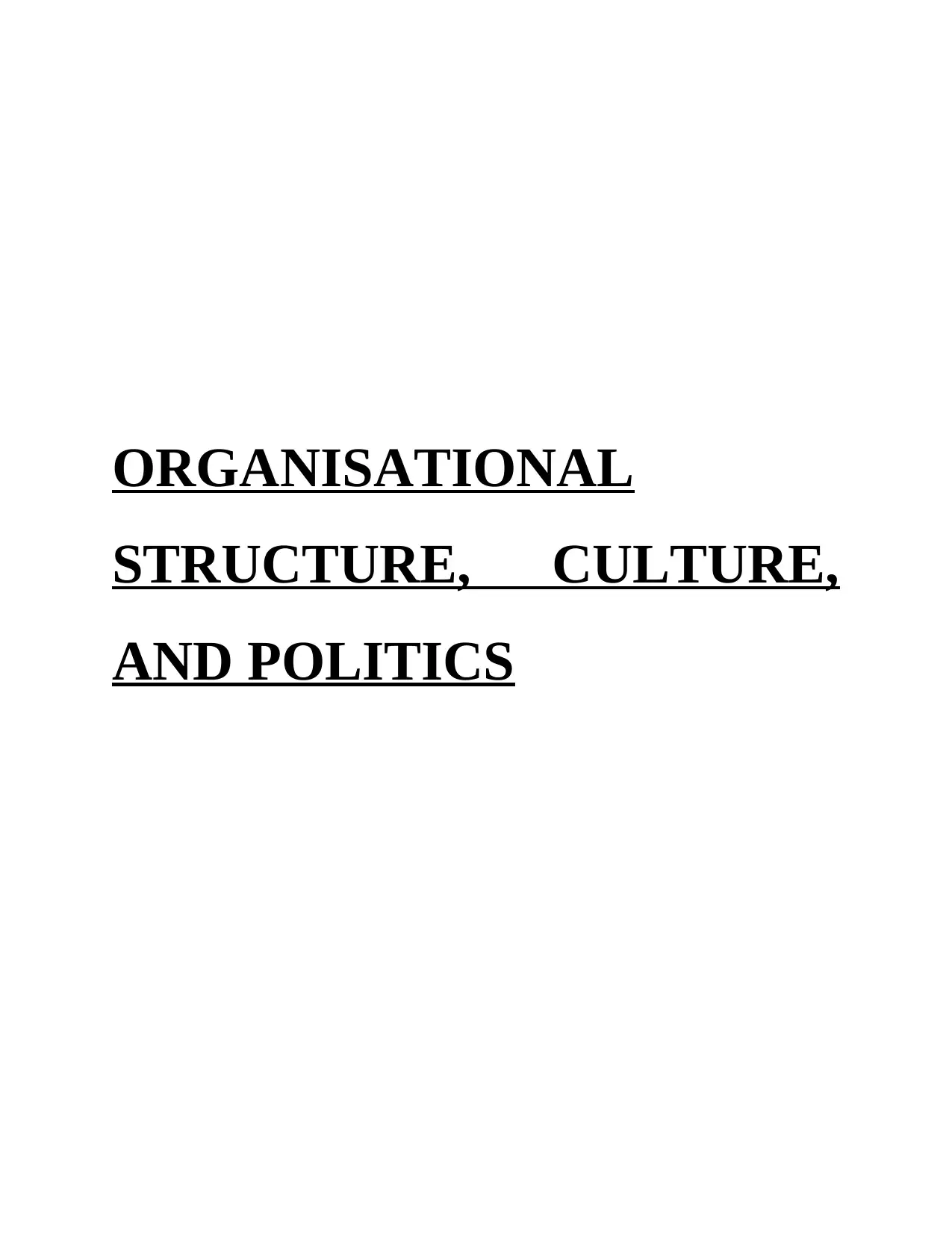
ORGANISATIONAL
STRUCTURE, CULTURE,
AND POLITICS
STRUCTURE, CULTURE,
AND POLITICS
Secure Best Marks with AI Grader
Need help grading? Try our AI Grader for instant feedback on your assignments.
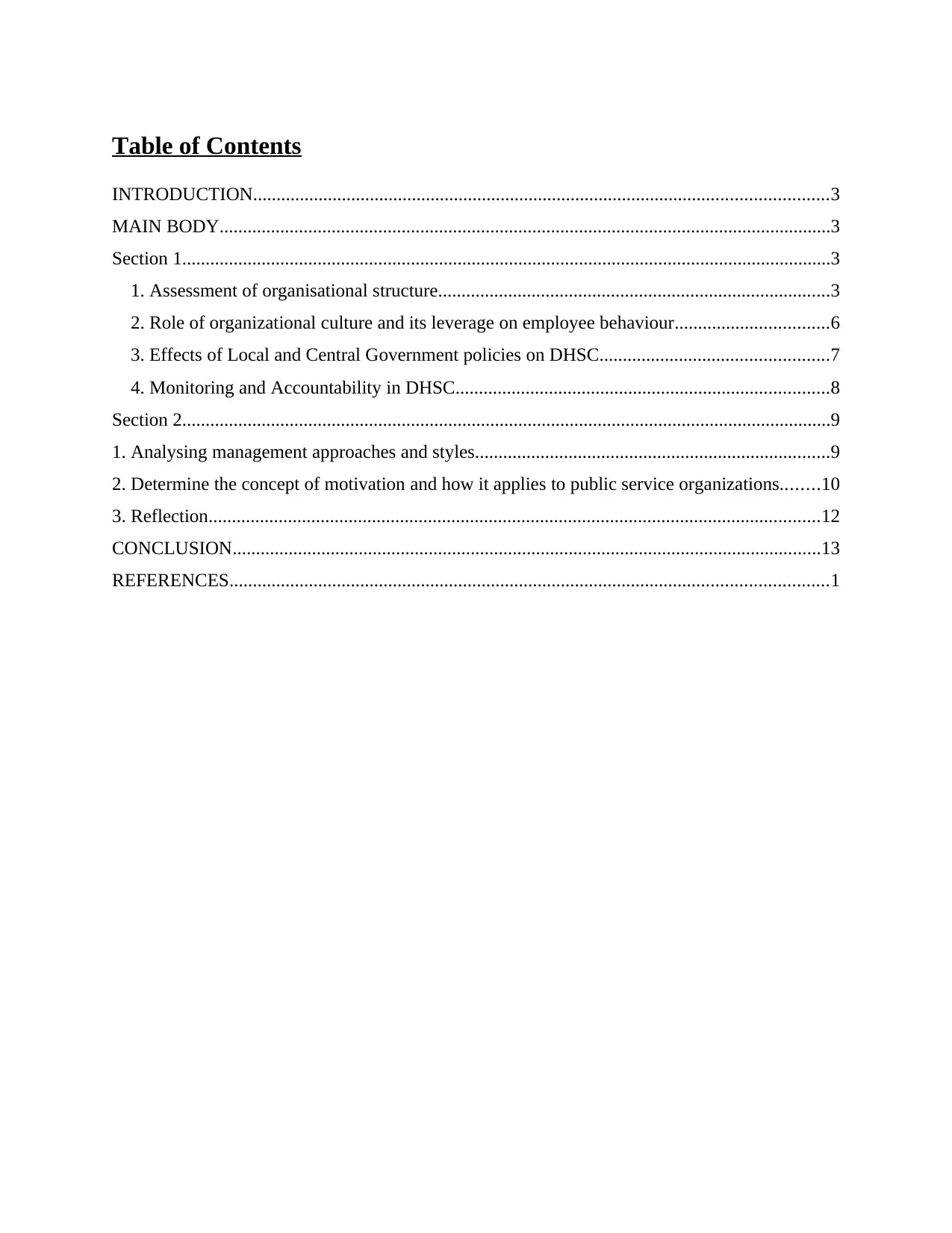
Table of Contents
INTRODUCTION...........................................................................................................................3
MAIN BODY...................................................................................................................................3
Section 1...........................................................................................................................................3
1. Assessment of organisational structure....................................................................................3
2. Role of organizational culture and its leverage on employee behaviour.................................6
3. Effects of Local and Central Government policies on DHSC.................................................7
4. Monitoring and Accountability in DHSC................................................................................8
Section 2...........................................................................................................................................9
1. Analysing management approaches and styles............................................................................9
2. Determine the concept of motivation and how it applies to public service organizations........10
3. Reflection...................................................................................................................................12
CONCLUSION..............................................................................................................................13
REFERENCES................................................................................................................................1
INTRODUCTION...........................................................................................................................3
MAIN BODY...................................................................................................................................3
Section 1...........................................................................................................................................3
1. Assessment of organisational structure....................................................................................3
2. Role of organizational culture and its leverage on employee behaviour.................................6
3. Effects of Local and Central Government policies on DHSC.................................................7
4. Monitoring and Accountability in DHSC................................................................................8
Section 2...........................................................................................................................................9
1. Analysing management approaches and styles............................................................................9
2. Determine the concept of motivation and how it applies to public service organizations........10
3. Reflection...................................................................................................................................12
CONCLUSION..............................................................................................................................13
REFERENCES................................................................................................................................1
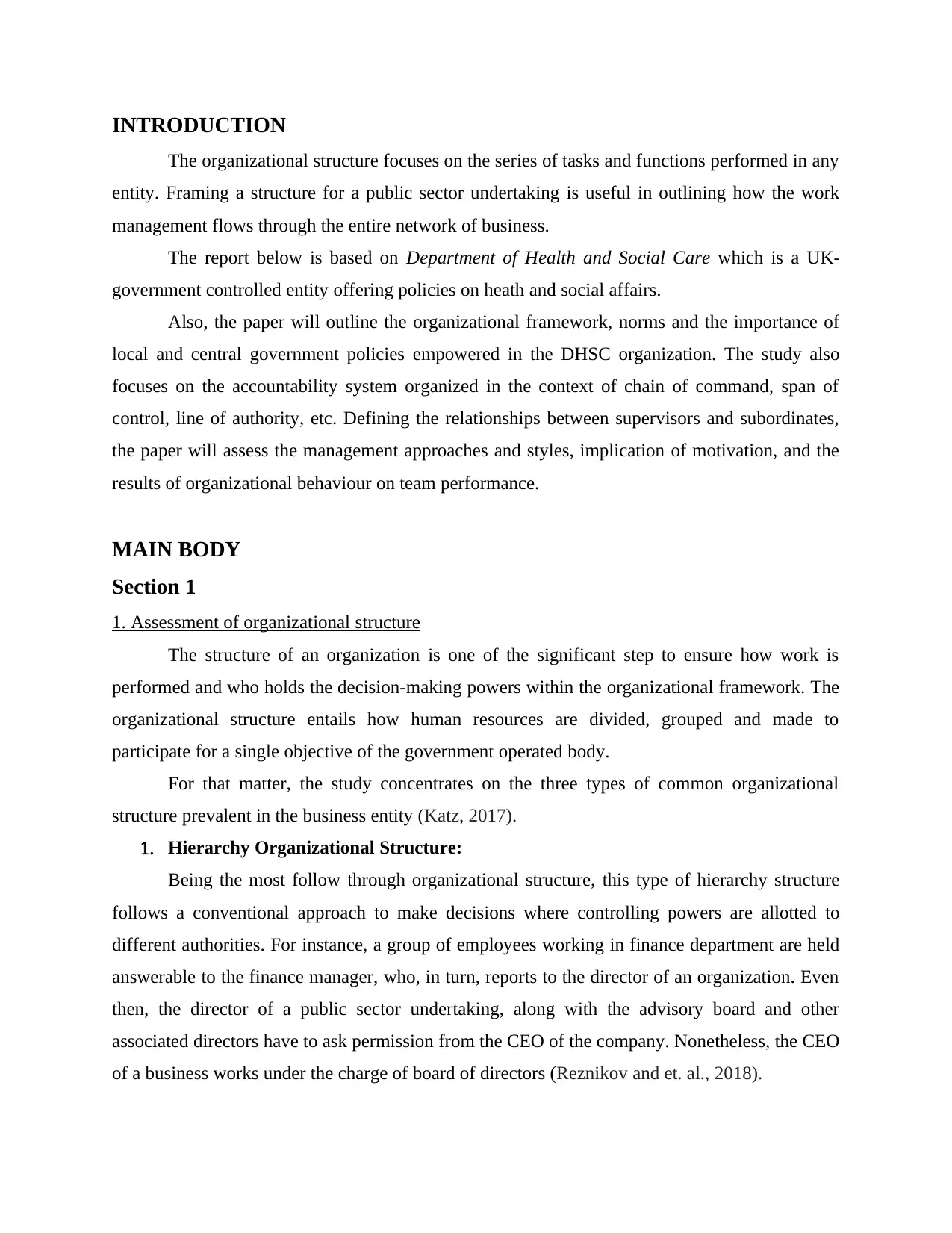
INTRODUCTION
The organizational structure focuses on the series of tasks and functions performed in any
entity. Framing a structure for a public sector undertaking is useful in outlining how the work
management flows through the entire network of business.
The report below is based on Department of Health and Social Care which is a UK-
government controlled entity offering policies on heath and social affairs.
Also, the paper will outline the organizational framework, norms and the importance of
local and central government policies empowered in the DHSC organization. The study also
focuses on the accountability system organized in the context of chain of command, span of
control, line of authority, etc. Defining the relationships between supervisors and subordinates,
the paper will assess the management approaches and styles, implication of motivation, and the
results of organizational behaviour on team performance.
MAIN BODY
Section 1
1. Assessment of organizational structure
The structure of an organization is one of the significant step to ensure how work is
performed and who holds the decision-making powers within the organizational framework. The
organizational structure entails how human resources are divided, grouped and made to
participate for a single objective of the government operated body.
For that matter, the study concentrates on the three types of common organizational
structure prevalent in the business entity (Katz, 2017).
1. Hierarchy Organizational Structure:
Being the most follow through organizational structure, this type of hierarchy structure
follows a conventional approach to make decisions where controlling powers are allotted to
different authorities. For instance, a group of employees working in finance department are held
answerable to the finance manager, who, in turn, reports to the director of an organization. Even
then, the director of a public sector undertaking, along with the advisory board and other
associated directors have to ask permission from the CEO of the company. Nonetheless, the CEO
of a business works under the charge of board of directors (Reznikov and et. al., 2018).
The organizational structure focuses on the series of tasks and functions performed in any
entity. Framing a structure for a public sector undertaking is useful in outlining how the work
management flows through the entire network of business.
The report below is based on Department of Health and Social Care which is a UK-
government controlled entity offering policies on heath and social affairs.
Also, the paper will outline the organizational framework, norms and the importance of
local and central government policies empowered in the DHSC organization. The study also
focuses on the accountability system organized in the context of chain of command, span of
control, line of authority, etc. Defining the relationships between supervisors and subordinates,
the paper will assess the management approaches and styles, implication of motivation, and the
results of organizational behaviour on team performance.
MAIN BODY
Section 1
1. Assessment of organizational structure
The structure of an organization is one of the significant step to ensure how work is
performed and who holds the decision-making powers within the organizational framework. The
organizational structure entails how human resources are divided, grouped and made to
participate for a single objective of the government operated body.
For that matter, the study concentrates on the three types of common organizational
structure prevalent in the business entity (Katz, 2017).
1. Hierarchy Organizational Structure:
Being the most follow through organizational structure, this type of hierarchy structure
follows a conventional approach to make decisions where controlling powers are allotted to
different authorities. For instance, a group of employees working in finance department are held
answerable to the finance manager, who, in turn, reports to the director of an organization. Even
then, the director of a public sector undertaking, along with the advisory board and other
associated directors have to ask permission from the CEO of the company. Nonetheless, the CEO
of a business works under the charge of board of directors (Reznikov and et. al., 2018).
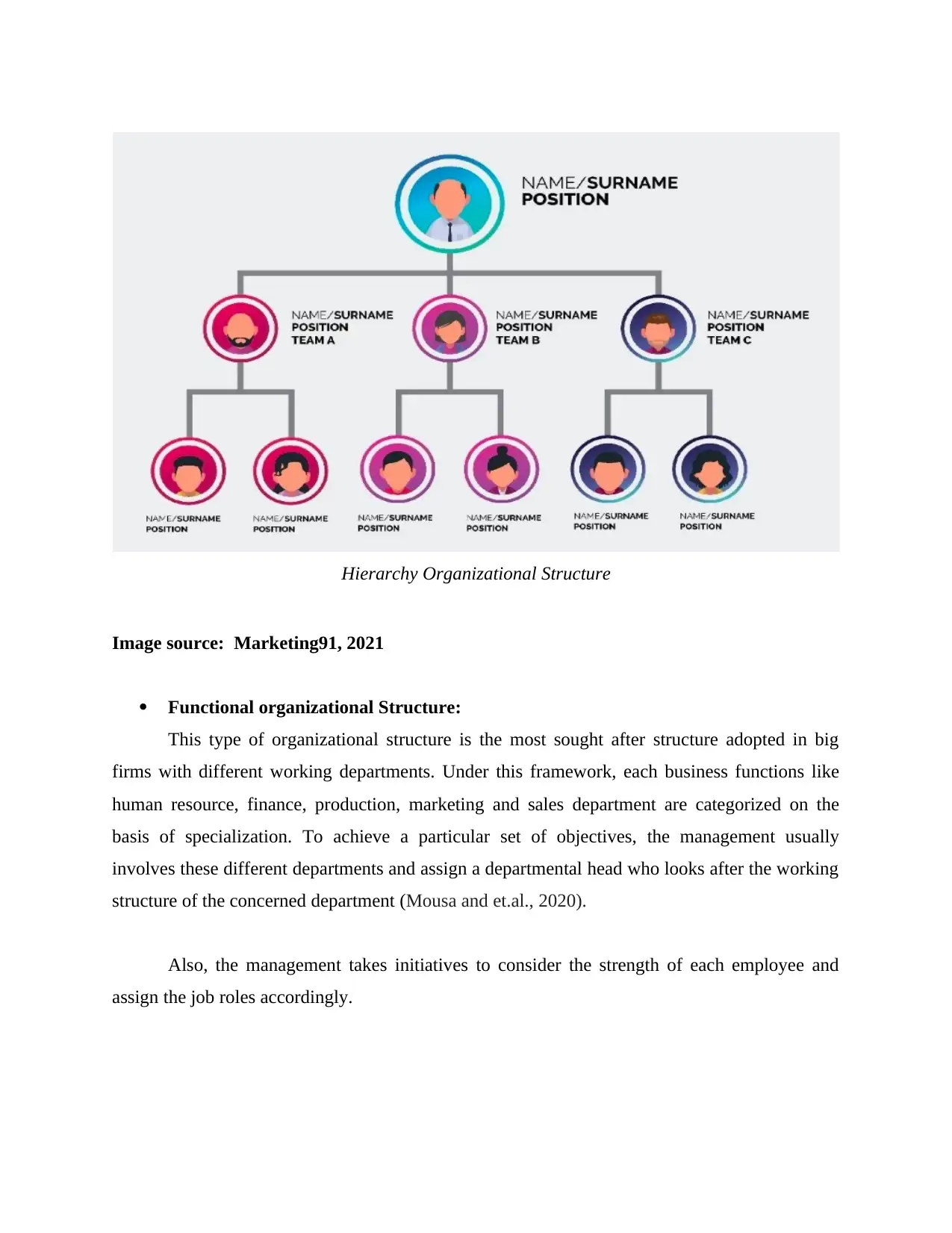
Image source: Marketing91, 2021
Functional organizational Structure:
This type of organizational structure is the most sought after structure adopted in big
firms with different working departments. Under this framework, each business functions like
human resource, finance, production, marketing and sales department are categorized on the
basis of specialization. To achieve a particular set of objectives, the management usually
involves these different departments and assign a departmental head who looks after the working
structure of the concerned department (Mousa and et.al., 2020).
Also, the management takes initiatives to consider the strength of each employee and
assign the job roles accordingly.
Hierarchy Organizational Structure
Functional organizational Structure:
This type of organizational structure is the most sought after structure adopted in big
firms with different working departments. Under this framework, each business functions like
human resource, finance, production, marketing and sales department are categorized on the
basis of specialization. To achieve a particular set of objectives, the management usually
involves these different departments and assign a departmental head who looks after the working
structure of the concerned department (Mousa and et.al., 2020).
Also, the management takes initiatives to consider the strength of each employee and
assign the job roles accordingly.
Hierarchy Organizational Structure
Secure Best Marks with AI Grader
Need help grading? Try our AI Grader for instant feedback on your assignments.
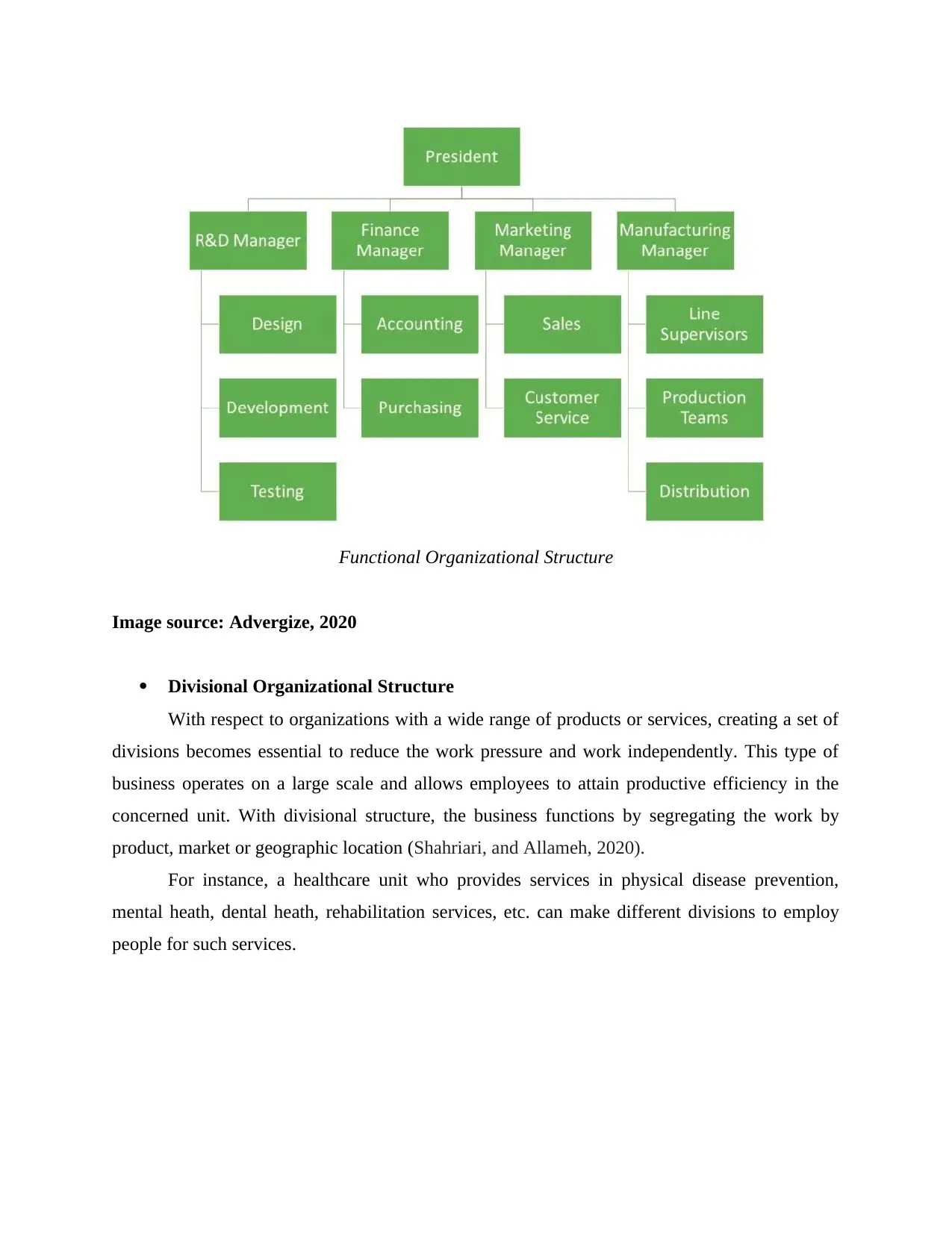
Image source: Advergize, 2020
Divisional Organizational Structure
With respect to organizations with a wide range of products or services, creating a set of
divisions becomes essential to reduce the work pressure and work independently. This type of
business operates on a large scale and allows employees to attain productive efficiency in the
concerned unit. With divisional structure, the business functions by segregating the work by
product, market or geographic location (Shahriari, and Allameh, 2020).
For instance, a healthcare unit who provides services in physical disease prevention,
mental heath, dental heath, rehabilitation services, etc. can make different divisions to employ
people for such services.
Functional Organizational Structure
Divisional Organizational Structure
With respect to organizations with a wide range of products or services, creating a set of
divisions becomes essential to reduce the work pressure and work independently. This type of
business operates on a large scale and allows employees to attain productive efficiency in the
concerned unit. With divisional structure, the business functions by segregating the work by
product, market or geographic location (Shahriari, and Allameh, 2020).
For instance, a healthcare unit who provides services in physical disease prevention,
mental heath, dental heath, rehabilitation services, etc. can make different divisions to employ
people for such services.
Functional Organizational Structure
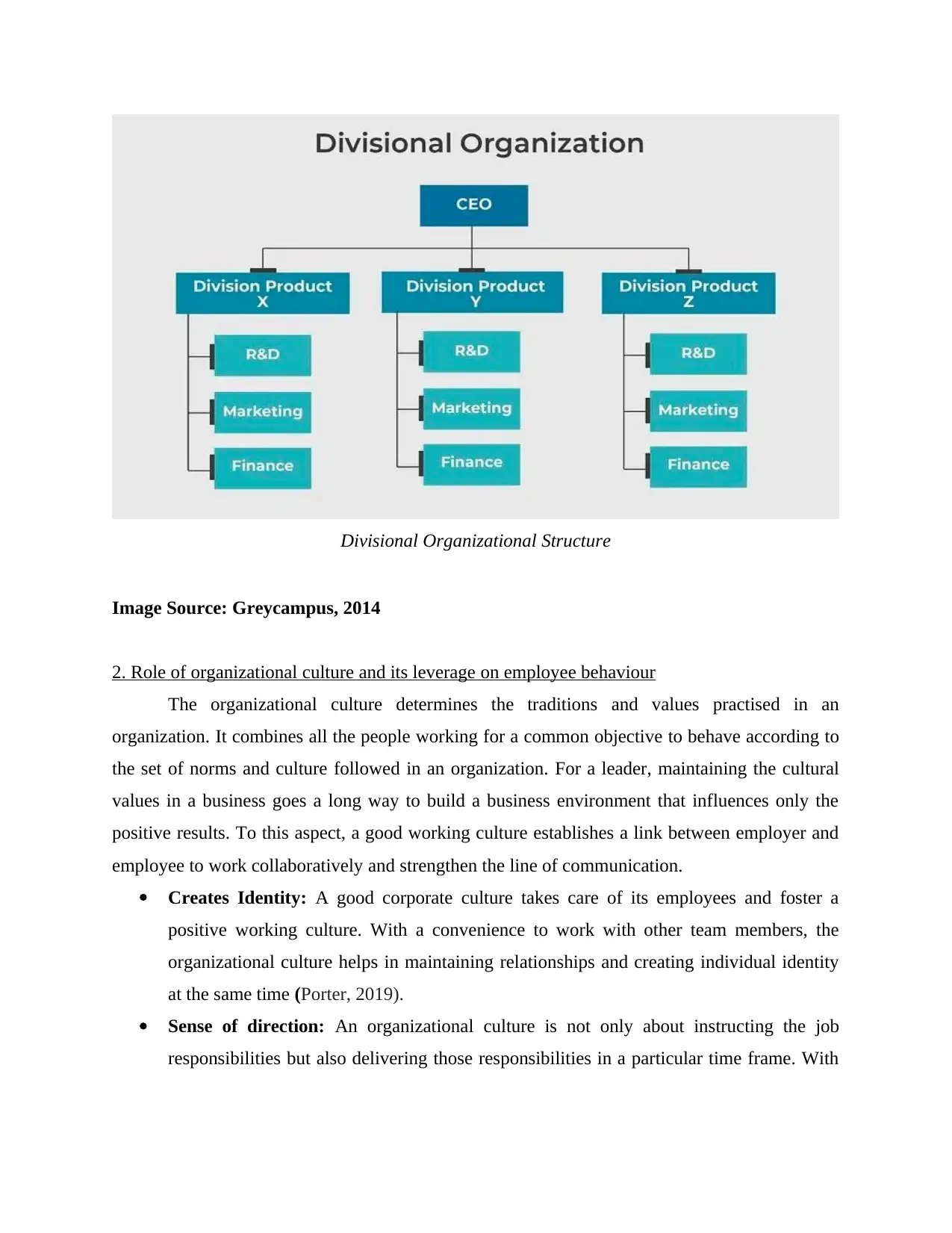
Image Source: Greycampus, 2014
2. Role of organizational culture and its leverage on employee behaviour
The organizational culture determines the traditions and values practised in an
organization. It combines all the people working for a common objective to behave according to
the set of norms and culture followed in an organization. For a leader, maintaining the cultural
values in a business goes a long way to build a business environment that influences only the
positive results. To this aspect, a good working culture establishes a link between employer and
employee to work collaboratively and strengthen the line of communication.
Creates Identity: A good corporate culture takes care of its employees and foster a
positive working culture. With a convenience to work with other team members, the
organizational culture helps in maintaining relationships and creating individual identity
at the same time (Porter, 2019).
Sense of direction: An organizational culture is not only about instructing the job
responsibilities but also delivering those responsibilities in a particular time frame. With
Divisional Organizational Structure
2. Role of organizational culture and its leverage on employee behaviour
The organizational culture determines the traditions and values practised in an
organization. It combines all the people working for a common objective to behave according to
the set of norms and culture followed in an organization. For a leader, maintaining the cultural
values in a business goes a long way to build a business environment that influences only the
positive results. To this aspect, a good working culture establishes a link between employer and
employee to work collaboratively and strengthen the line of communication.
Creates Identity: A good corporate culture takes care of its employees and foster a
positive working culture. With a convenience to work with other team members, the
organizational culture helps in maintaining relationships and creating individual identity
at the same time (Porter, 2019).
Sense of direction: An organizational culture is not only about instructing the job
responsibilities but also delivering those responsibilities in a particular time frame. With
Divisional Organizational Structure
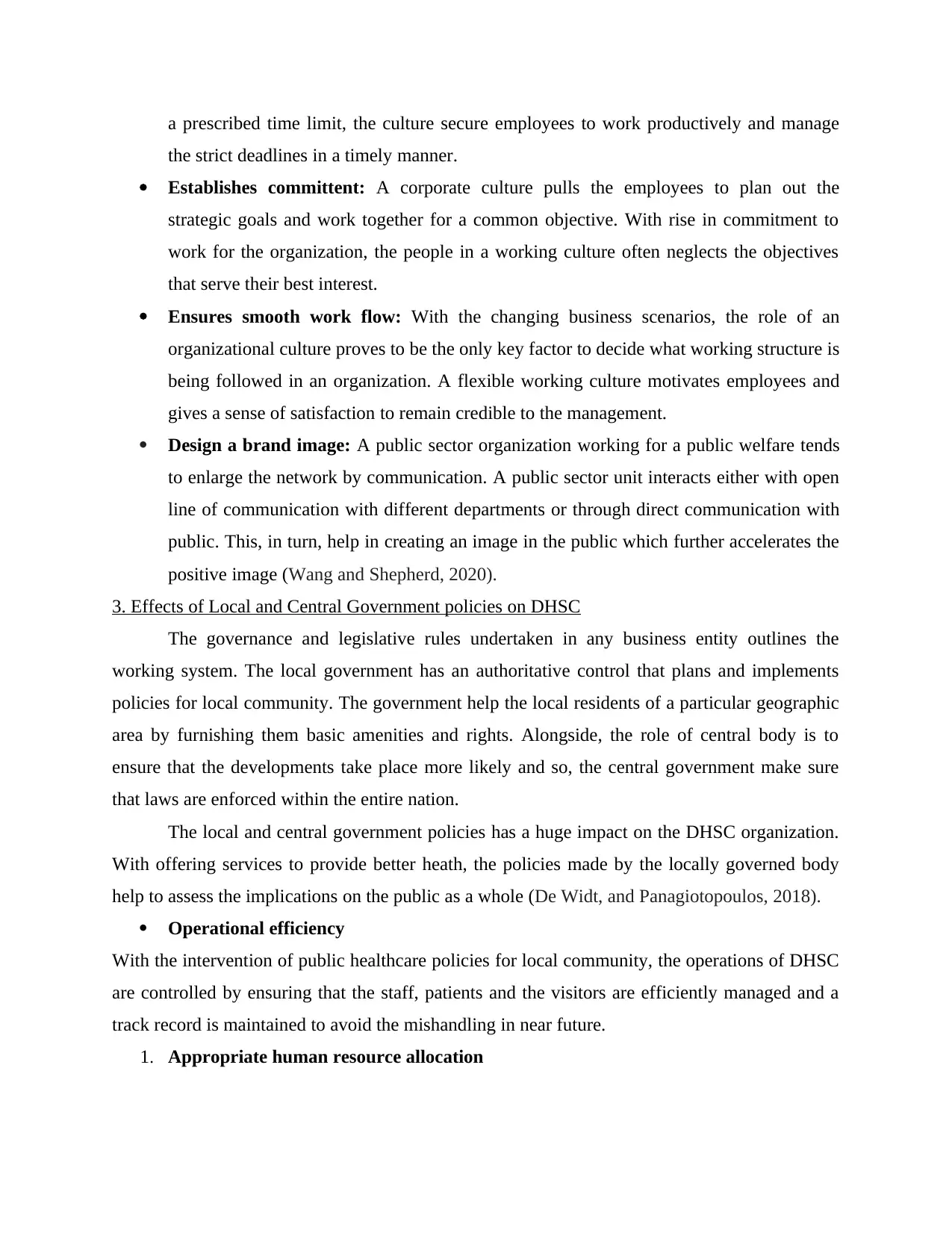
a prescribed time limit, the culture secure employees to work productively and manage
the strict deadlines in a timely manner.
Establishes committent: A corporate culture pulls the employees to plan out the
strategic goals and work together for a common objective. With rise in commitment to
work for the organization, the people in a working culture often neglects the objectives
that serve their best interest.
Ensures smooth work flow: With the changing business scenarios, the role of an
organizational culture proves to be the only key factor to decide what working structure is
being followed in an organization. A flexible working culture motivates employees and
gives a sense of satisfaction to remain credible to the management.
Design a brand image: A public sector organization working for a public welfare tends
to enlarge the network by communication. A public sector unit interacts either with open
line of communication with different departments or through direct communication with
public. This, in turn, help in creating an image in the public which further accelerates the
positive image (Wang and Shepherd, 2020).
3. Effects of Local and Central Government policies on DHSC
The governance and legislative rules undertaken in any business entity outlines the
working system. The local government has an authoritative control that plans and implements
policies for local community. The government help the local residents of a particular geographic
area by furnishing them basic amenities and rights. Alongside, the role of central body is to
ensure that the developments take place more likely and so, the central government make sure
that laws are enforced within the entire nation.
The local and central government policies has a huge impact on the DHSC organization.
With offering services to provide better heath, the policies made by the locally governed body
help to assess the implications on the public as a whole (De Widt, and Panagiotopoulos, 2018).
Operational efficiency
With the intervention of public healthcare policies for local community, the operations of DHSC
are controlled by ensuring that the staff, patients and the visitors are efficiently managed and a
track record is maintained to avoid the mishandling in near future.
1. Appropriate human resource allocation
the strict deadlines in a timely manner.
Establishes committent: A corporate culture pulls the employees to plan out the
strategic goals and work together for a common objective. With rise in commitment to
work for the organization, the people in a working culture often neglects the objectives
that serve their best interest.
Ensures smooth work flow: With the changing business scenarios, the role of an
organizational culture proves to be the only key factor to decide what working structure is
being followed in an organization. A flexible working culture motivates employees and
gives a sense of satisfaction to remain credible to the management.
Design a brand image: A public sector organization working for a public welfare tends
to enlarge the network by communication. A public sector unit interacts either with open
line of communication with different departments or through direct communication with
public. This, in turn, help in creating an image in the public which further accelerates the
positive image (Wang and Shepherd, 2020).
3. Effects of Local and Central Government policies on DHSC
The governance and legislative rules undertaken in any business entity outlines the
working system. The local government has an authoritative control that plans and implements
policies for local community. The government help the local residents of a particular geographic
area by furnishing them basic amenities and rights. Alongside, the role of central body is to
ensure that the developments take place more likely and so, the central government make sure
that laws are enforced within the entire nation.
The local and central government policies has a huge impact on the DHSC organization.
With offering services to provide better heath, the policies made by the locally governed body
help to assess the implications on the public as a whole (De Widt, and Panagiotopoulos, 2018).
Operational efficiency
With the intervention of public healthcare policies for local community, the operations of DHSC
are controlled by ensuring that the staff, patients and the visitors are efficiently managed and a
track record is maintained to avoid the mishandling in near future.
1. Appropriate human resource allocation
Paraphrase This Document
Need a fresh take? Get an instant paraphrase of this document with our AI Paraphraser
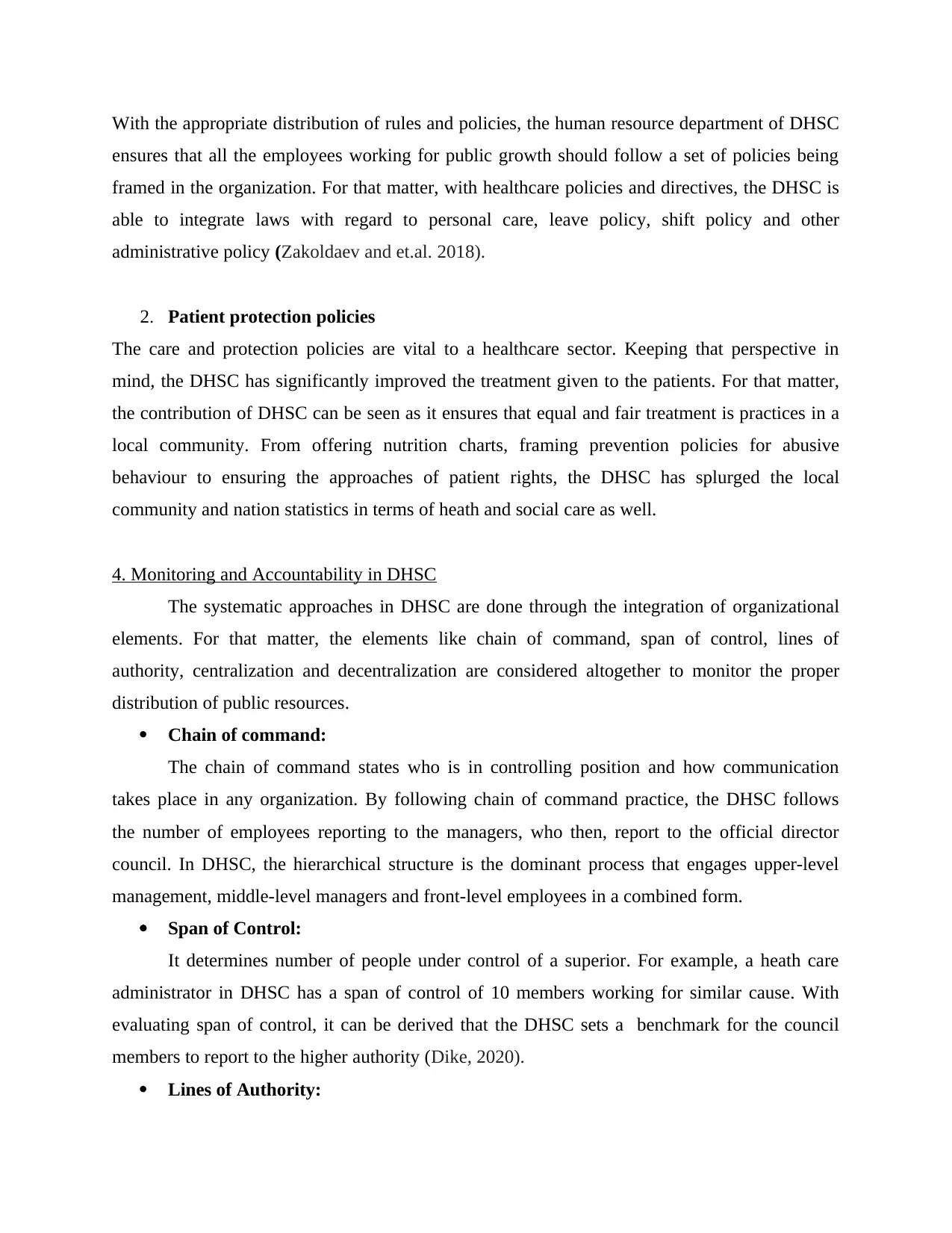
With the appropriate distribution of rules and policies, the human resource department of DHSC
ensures that all the employees working for public growth should follow a set of policies being
framed in the organization. For that matter, with healthcare policies and directives, the DHSC is
able to integrate laws with regard to personal care, leave policy, shift policy and other
administrative policy (Zakoldaev and et.al. 2018).
2. Patient protection policies
The care and protection policies are vital to a healthcare sector. Keeping that perspective in
mind, the DHSC has significantly improved the treatment given to the patients. For that matter,
the contribution of DHSC can be seen as it ensures that equal and fair treatment is practices in a
local community. From offering nutrition charts, framing prevention policies for abusive
behaviour to ensuring the approaches of patient rights, the DHSC has splurged the local
community and nation statistics in terms of heath and social care as well.
4. Monitoring and Accountability in DHSC
The systematic approaches in DHSC are done through the integration of organizational
elements. For that matter, the elements like chain of command, span of control, lines of
authority, centralization and decentralization are considered altogether to monitor the proper
distribution of public resources.
Chain of command:
The chain of command states who is in controlling position and how communication
takes place in any organization. By following chain of command practice, the DHSC follows
the number of employees reporting to the managers, who then, report to the official director
council. In DHSC, the hierarchical structure is the dominant process that engages upper-level
management, middle-level managers and front-level employees in a combined form.
Span of Control:
It determines number of people under control of a superior. For example, a heath care
administrator in DHSC has a span of control of 10 members working for similar cause. With
evaluating span of control, it can be derived that the DHSC sets a benchmark for the council
members to report to the higher authority (Dike, 2020).
Lines of Authority:
ensures that all the employees working for public growth should follow a set of policies being
framed in the organization. For that matter, with healthcare policies and directives, the DHSC is
able to integrate laws with regard to personal care, leave policy, shift policy and other
administrative policy (Zakoldaev and et.al. 2018).
2. Patient protection policies
The care and protection policies are vital to a healthcare sector. Keeping that perspective in
mind, the DHSC has significantly improved the treatment given to the patients. For that matter,
the contribution of DHSC can be seen as it ensures that equal and fair treatment is practices in a
local community. From offering nutrition charts, framing prevention policies for abusive
behaviour to ensuring the approaches of patient rights, the DHSC has splurged the local
community and nation statistics in terms of heath and social care as well.
4. Monitoring and Accountability in DHSC
The systematic approaches in DHSC are done through the integration of organizational
elements. For that matter, the elements like chain of command, span of control, lines of
authority, centralization and decentralization are considered altogether to monitor the proper
distribution of public resources.
Chain of command:
The chain of command states who is in controlling position and how communication
takes place in any organization. By following chain of command practice, the DHSC follows
the number of employees reporting to the managers, who then, report to the official director
council. In DHSC, the hierarchical structure is the dominant process that engages upper-level
management, middle-level managers and front-level employees in a combined form.
Span of Control:
It determines number of people under control of a superior. For example, a heath care
administrator in DHSC has a span of control of 10 members working for similar cause. With
evaluating span of control, it can be derived that the DHSC sets a benchmark for the council
members to report to the higher authority (Dike, 2020).
Lines of Authority:
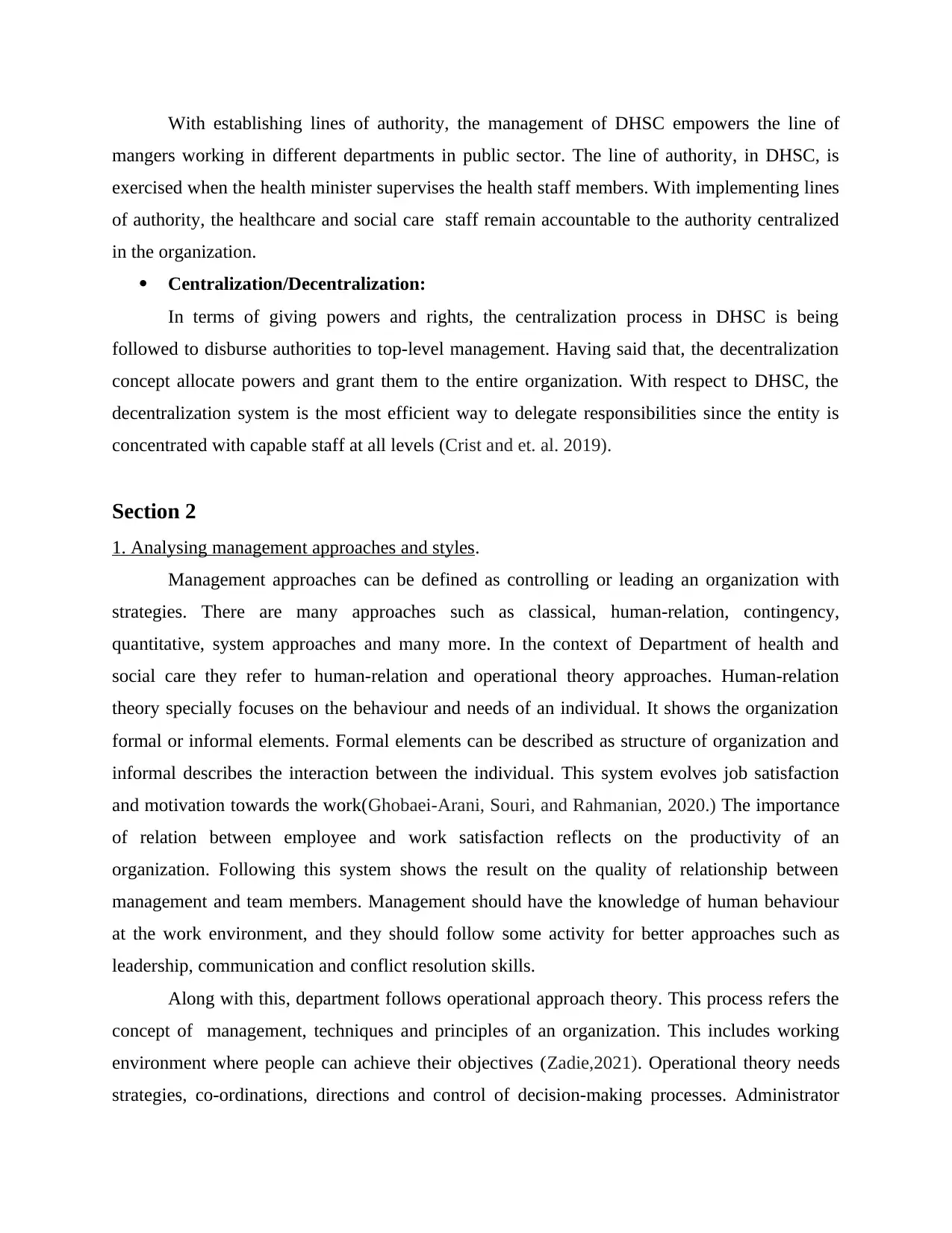
With establishing lines of authority, the management of DHSC empowers the line of
mangers working in different departments in public sector. The line of authority, in DHSC, is
exercised when the health minister supervises the health staff members. With implementing lines
of authority, the healthcare and social care staff remain accountable to the authority centralized
in the organization.
Centralization/Decentralization:
In terms of giving powers and rights, the centralization process in DHSC is being
followed to disburse authorities to top-level management. Having said that, the decentralization
concept allocate powers and grant them to the entire organization. With respect to DHSC, the
decentralization system is the most efficient way to delegate responsibilities since the entity is
concentrated with capable staff at all levels (Crist and et. al. 2019).
Section 2
1. Analysing management approaches and styles.
Management approaches can be defined as controlling or leading an organization with
strategies. There are many approaches such as classical, human-relation, contingency,
quantitative, system approaches and many more. In the context of Department of health and
social care they refer to human-relation and operational theory approaches. Human-relation
theory specially focuses on the behaviour and needs of an individual. It shows the organization
formal or informal elements. Formal elements can be described as structure of organization and
informal describes the interaction between the individual. This system evolves job satisfaction
and motivation towards the work(Ghobaei-Arani, Souri, and Rahmanian, 2020.) The importance
of relation between employee and work satisfaction reflects on the productivity of an
organization. Following this system shows the result on the quality of relationship between
management and team members. Management should have the knowledge of human behaviour
at the work environment, and they should follow some activity for better approaches such as
leadership, communication and conflict resolution skills.
Along with this, department follows operational approach theory. This process refers the
concept of management, techniques and principles of an organization. This includes working
environment where people can achieve their objectives (Zadie,2021). Operational theory needs
strategies, co-ordinations, directions and control of decision-making processes. Administrator
mangers working in different departments in public sector. The line of authority, in DHSC, is
exercised when the health minister supervises the health staff members. With implementing lines
of authority, the healthcare and social care staff remain accountable to the authority centralized
in the organization.
Centralization/Decentralization:
In terms of giving powers and rights, the centralization process in DHSC is being
followed to disburse authorities to top-level management. Having said that, the decentralization
concept allocate powers and grant them to the entire organization. With respect to DHSC, the
decentralization system is the most efficient way to delegate responsibilities since the entity is
concentrated with capable staff at all levels (Crist and et. al. 2019).
Section 2
1. Analysing management approaches and styles.
Management approaches can be defined as controlling or leading an organization with
strategies. There are many approaches such as classical, human-relation, contingency,
quantitative, system approaches and many more. In the context of Department of health and
social care they refer to human-relation and operational theory approaches. Human-relation
theory specially focuses on the behaviour and needs of an individual. It shows the organization
formal or informal elements. Formal elements can be described as structure of organization and
informal describes the interaction between the individual. This system evolves job satisfaction
and motivation towards the work(Ghobaei-Arani, Souri, and Rahmanian, 2020.) The importance
of relation between employee and work satisfaction reflects on the productivity of an
organization. Following this system shows the result on the quality of relationship between
management and team members. Management should have the knowledge of human behaviour
at the work environment, and they should follow some activity for better approaches such as
leadership, communication and conflict resolution skills.
Along with this, department follows operational approach theory. This process refers the
concept of management, techniques and principles of an organization. This includes working
environment where people can achieve their objectives (Zadie,2021). Operational theory needs
strategies, co-ordinations, directions and control of decision-making processes. Administrator
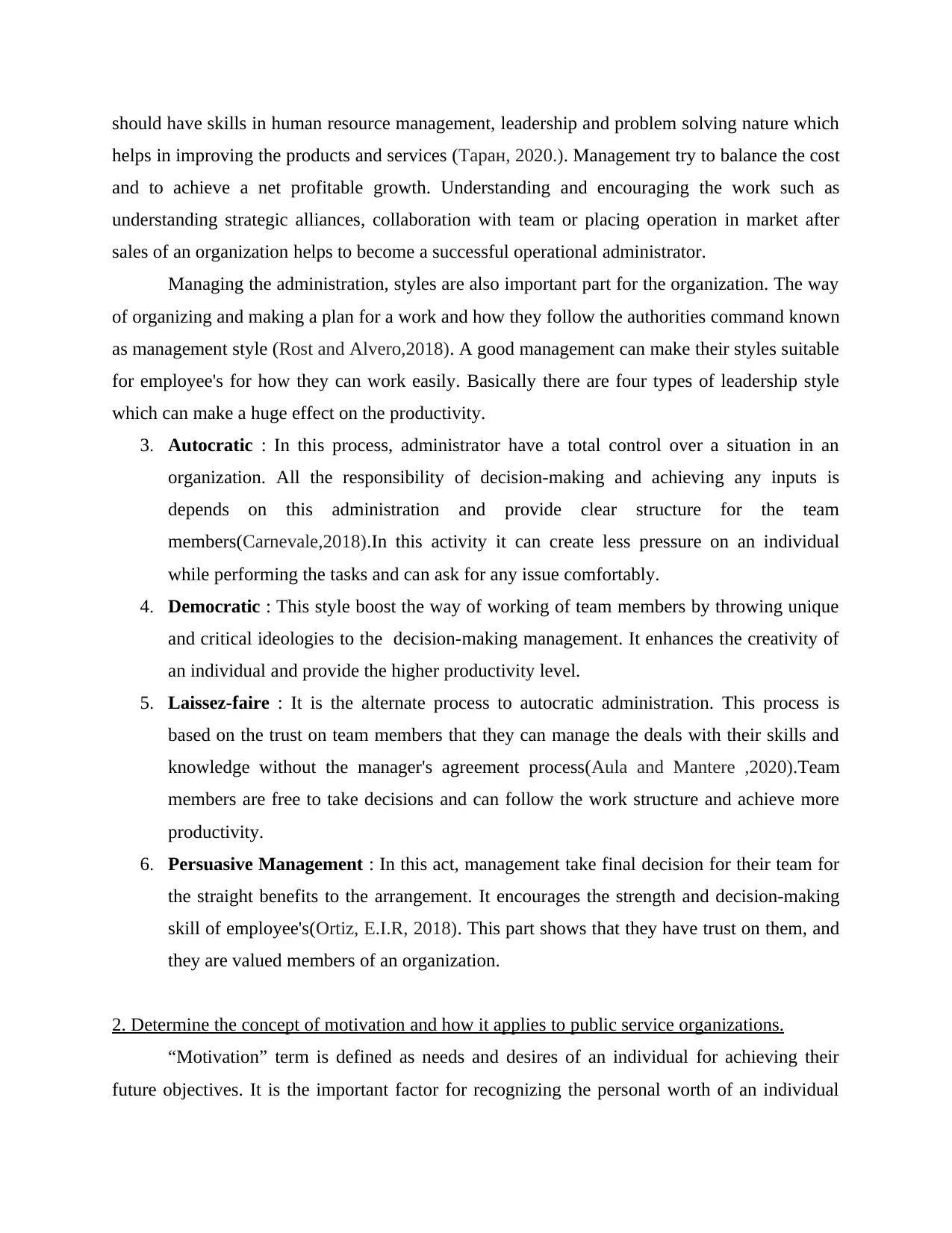
should have skills in human resource management, leadership and problem solving nature which
helps in improving the products and services (Таран, 2020.). Management try to balance the cost
and to achieve a net profitable growth. Understanding and encouraging the work such as
understanding strategic alliances, collaboration with team or placing operation in market after
sales of an organization helps to become a successful operational administrator.
Managing the administration, styles are also important part for the organization. The way
of organizing and making a plan for a work and how they follow the authorities command known
as management style (Rost and Alvero,2018). A good management can make their styles suitable
for employee's for how they can work easily. Basically there are four types of leadership style
which can make a huge effect on the productivity.
3. Autocratic : In this process, administrator have a total control over a situation in an
organization. All the responsibility of decision-making and achieving any inputs is
depends on this administration and provide clear structure for the team
members(Carnevale,2018).In this activity it can create less pressure on an individual
while performing the tasks and can ask for any issue comfortably.
4. Democratic : This style boost the way of working of team members by throwing unique
and critical ideologies to the decision-making management. It enhances the creativity of
an individual and provide the higher productivity level.
5. Laissez-faire : It is the alternate process to autocratic administration. This process is
based on the trust on team members that they can manage the deals with their skills and
knowledge without the manager's agreement process(Aula and Mantere ,2020).Team
members are free to take decisions and can follow the work structure and achieve more
productivity.
6. Persuasive Management : In this act, management take final decision for their team for
the straight benefits to the arrangement. It encourages the strength and decision-making
skill of employee's(Ortiz, E.I.R, 2018). This part shows that they have trust on them, and
they are valued members of an organization.
2. Determine the concept of motivation and how it applies to public service organizations.
“Motivation” term is defined as needs and desires of an individual for achieving their
future objectives. It is the important factor for recognizing the personal worth of an individual
helps in improving the products and services (Таран, 2020.). Management try to balance the cost
and to achieve a net profitable growth. Understanding and encouraging the work such as
understanding strategic alliances, collaboration with team or placing operation in market after
sales of an organization helps to become a successful operational administrator.
Managing the administration, styles are also important part for the organization. The way
of organizing and making a plan for a work and how they follow the authorities command known
as management style (Rost and Alvero,2018). A good management can make their styles suitable
for employee's for how they can work easily. Basically there are four types of leadership style
which can make a huge effect on the productivity.
3. Autocratic : In this process, administrator have a total control over a situation in an
organization. All the responsibility of decision-making and achieving any inputs is
depends on this administration and provide clear structure for the team
members(Carnevale,2018).In this activity it can create less pressure on an individual
while performing the tasks and can ask for any issue comfortably.
4. Democratic : This style boost the way of working of team members by throwing unique
and critical ideologies to the decision-making management. It enhances the creativity of
an individual and provide the higher productivity level.
5. Laissez-faire : It is the alternate process to autocratic administration. This process is
based on the trust on team members that they can manage the deals with their skills and
knowledge without the manager's agreement process(Aula and Mantere ,2020).Team
members are free to take decisions and can follow the work structure and achieve more
productivity.
6. Persuasive Management : In this act, management take final decision for their team for
the straight benefits to the arrangement. It encourages the strength and decision-making
skill of employee's(Ortiz, E.I.R, 2018). This part shows that they have trust on them, and
they are valued members of an organization.
2. Determine the concept of motivation and how it applies to public service organizations.
“Motivation” term is defined as needs and desires of an individual for achieving their
future objectives. It is the important factor for recognizing the personal worth of an individual
Secure Best Marks with AI Grader
Need help grading? Try our AI Grader for instant feedback on your assignments.
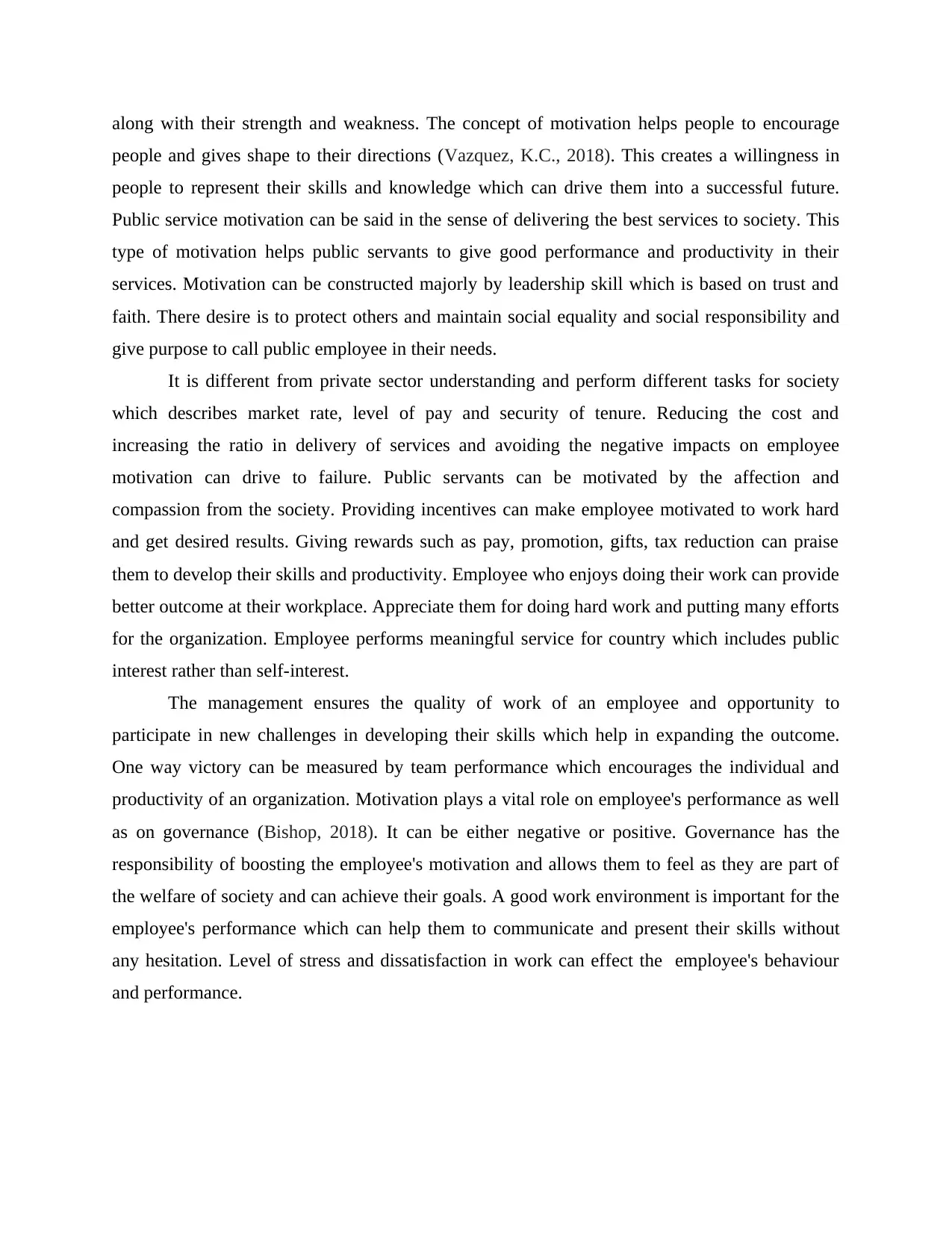
along with their strength and weakness. The concept of motivation helps people to encourage
people and gives shape to their directions (Vazquez, K.C., 2018). This creates a willingness in
people to represent their skills and knowledge which can drive them into a successful future.
Public service motivation can be said in the sense of delivering the best services to society. This
type of motivation helps public servants to give good performance and productivity in their
services. Motivation can be constructed majorly by leadership skill which is based on trust and
faith. There desire is to protect others and maintain social equality and social responsibility and
give purpose to call public employee in their needs.
It is different from private sector understanding and perform different tasks for society
which describes market rate, level of pay and security of tenure. Reducing the cost and
increasing the ratio in delivery of services and avoiding the negative impacts on employee
motivation can drive to failure. Public servants can be motivated by the affection and
compassion from the society. Providing incentives can make employee motivated to work hard
and get desired results. Giving rewards such as pay, promotion, gifts, tax reduction can praise
them to develop their skills and productivity. Employee who enjoys doing their work can provide
better outcome at their workplace. Appreciate them for doing hard work and putting many efforts
for the organization. Employee performs meaningful service for country which includes public
interest rather than self-interest.
The management ensures the quality of work of an employee and opportunity to
participate in new challenges in developing their skills which help in expanding the outcome.
One way victory can be measured by team performance which encourages the individual and
productivity of an organization. Motivation plays a vital role on employee's performance as well
as on governance (Bishop, 2018). It can be either negative or positive. Governance has the
responsibility of boosting the employee's motivation and allows them to feel as they are part of
the welfare of society and can achieve their goals. A good work environment is important for the
employee's performance which can help them to communicate and present their skills without
any hesitation. Level of stress and dissatisfaction in work can effect the employee's behaviour
and performance.
people and gives shape to their directions (Vazquez, K.C., 2018). This creates a willingness in
people to represent their skills and knowledge which can drive them into a successful future.
Public service motivation can be said in the sense of delivering the best services to society. This
type of motivation helps public servants to give good performance and productivity in their
services. Motivation can be constructed majorly by leadership skill which is based on trust and
faith. There desire is to protect others and maintain social equality and social responsibility and
give purpose to call public employee in their needs.
It is different from private sector understanding and perform different tasks for society
which describes market rate, level of pay and security of tenure. Reducing the cost and
increasing the ratio in delivery of services and avoiding the negative impacts on employee
motivation can drive to failure. Public servants can be motivated by the affection and
compassion from the society. Providing incentives can make employee motivated to work hard
and get desired results. Giving rewards such as pay, promotion, gifts, tax reduction can praise
them to develop their skills and productivity. Employee who enjoys doing their work can provide
better outcome at their workplace. Appreciate them for doing hard work and putting many efforts
for the organization. Employee performs meaningful service for country which includes public
interest rather than self-interest.
The management ensures the quality of work of an employee and opportunity to
participate in new challenges in developing their skills which help in expanding the outcome.
One way victory can be measured by team performance which encourages the individual and
productivity of an organization. Motivation plays a vital role on employee's performance as well
as on governance (Bishop, 2018). It can be either negative or positive. Governance has the
responsibility of boosting the employee's motivation and allows them to feel as they are part of
the welfare of society and can achieve their goals. A good work environment is important for the
employee's performance which can help them to communicate and present their skills without
any hesitation. Level of stress and dissatisfaction in work can effect the employee's behaviour
and performance.
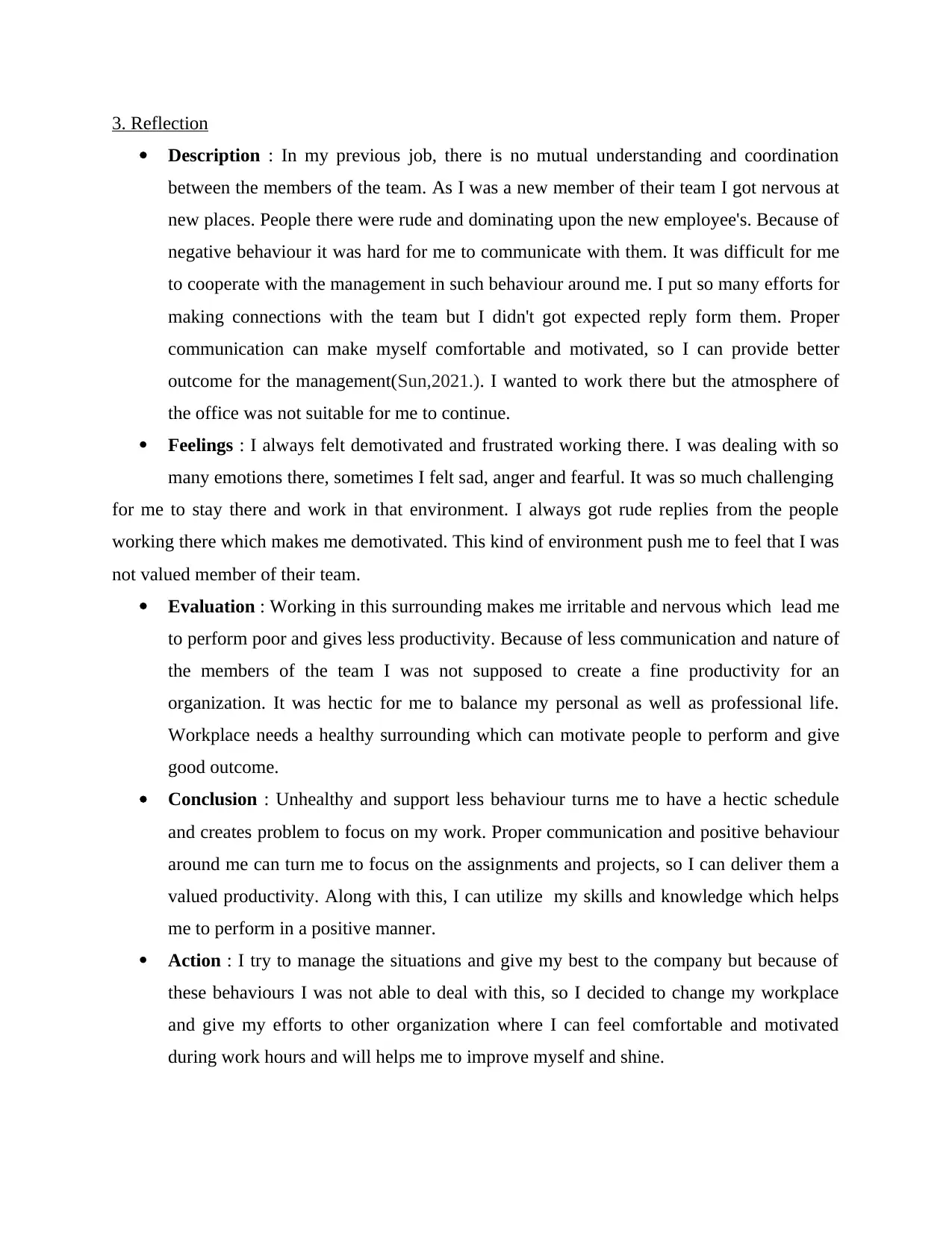
3. Reflection
Description : In my previous job, there is no mutual understanding and coordination
between the members of the team. As I was a new member of their team I got nervous at
new places. People there were rude and dominating upon the new employee's. Because of
negative behaviour it was hard for me to communicate with them. It was difficult for me
to cooperate with the management in such behaviour around me. I put so many efforts for
making connections with the team but I didn't got expected reply form them. Proper
communication can make myself comfortable and motivated, so I can provide better
outcome for the management(Sun,2021.). I wanted to work there but the atmosphere of
the office was not suitable for me to continue.
Feelings : I always felt demotivated and frustrated working there. I was dealing with so
many emotions there, sometimes I felt sad, anger and fearful. It was so much challenging
for me to stay there and work in that environment. I always got rude replies from the people
working there which makes me demotivated. This kind of environment push me to feel that I was
not valued member of their team.
Evaluation : Working in this surrounding makes me irritable and nervous which lead me
to perform poor and gives less productivity. Because of less communication and nature of
the members of the team I was not supposed to create a fine productivity for an
organization. It was hectic for me to balance my personal as well as professional life.
Workplace needs a healthy surrounding which can motivate people to perform and give
good outcome.
Conclusion : Unhealthy and support less behaviour turns me to have a hectic schedule
and creates problem to focus on my work. Proper communication and positive behaviour
around me can turn me to focus on the assignments and projects, so I can deliver them a
valued productivity. Along with this, I can utilize my skills and knowledge which helps
me to perform in a positive manner.
Action : I try to manage the situations and give my best to the company but because of
these behaviours I was not able to deal with this, so I decided to change my workplace
and give my efforts to other organization where I can feel comfortable and motivated
during work hours and will helps me to improve myself and shine.
Description : In my previous job, there is no mutual understanding and coordination
between the members of the team. As I was a new member of their team I got nervous at
new places. People there were rude and dominating upon the new employee's. Because of
negative behaviour it was hard for me to communicate with them. It was difficult for me
to cooperate with the management in such behaviour around me. I put so many efforts for
making connections with the team but I didn't got expected reply form them. Proper
communication can make myself comfortable and motivated, so I can provide better
outcome for the management(Sun,2021.). I wanted to work there but the atmosphere of
the office was not suitable for me to continue.
Feelings : I always felt demotivated and frustrated working there. I was dealing with so
many emotions there, sometimes I felt sad, anger and fearful. It was so much challenging
for me to stay there and work in that environment. I always got rude replies from the people
working there which makes me demotivated. This kind of environment push me to feel that I was
not valued member of their team.
Evaluation : Working in this surrounding makes me irritable and nervous which lead me
to perform poor and gives less productivity. Because of less communication and nature of
the members of the team I was not supposed to create a fine productivity for an
organization. It was hectic for me to balance my personal as well as professional life.
Workplace needs a healthy surrounding which can motivate people to perform and give
good outcome.
Conclusion : Unhealthy and support less behaviour turns me to have a hectic schedule
and creates problem to focus on my work. Proper communication and positive behaviour
around me can turn me to focus on the assignments and projects, so I can deliver them a
valued productivity. Along with this, I can utilize my skills and knowledge which helps
me to perform in a positive manner.
Action : I try to manage the situations and give my best to the company but because of
these behaviours I was not able to deal with this, so I decided to change my workplace
and give my efforts to other organization where I can feel comfortable and motivated
during work hours and will helps me to improve myself and shine.
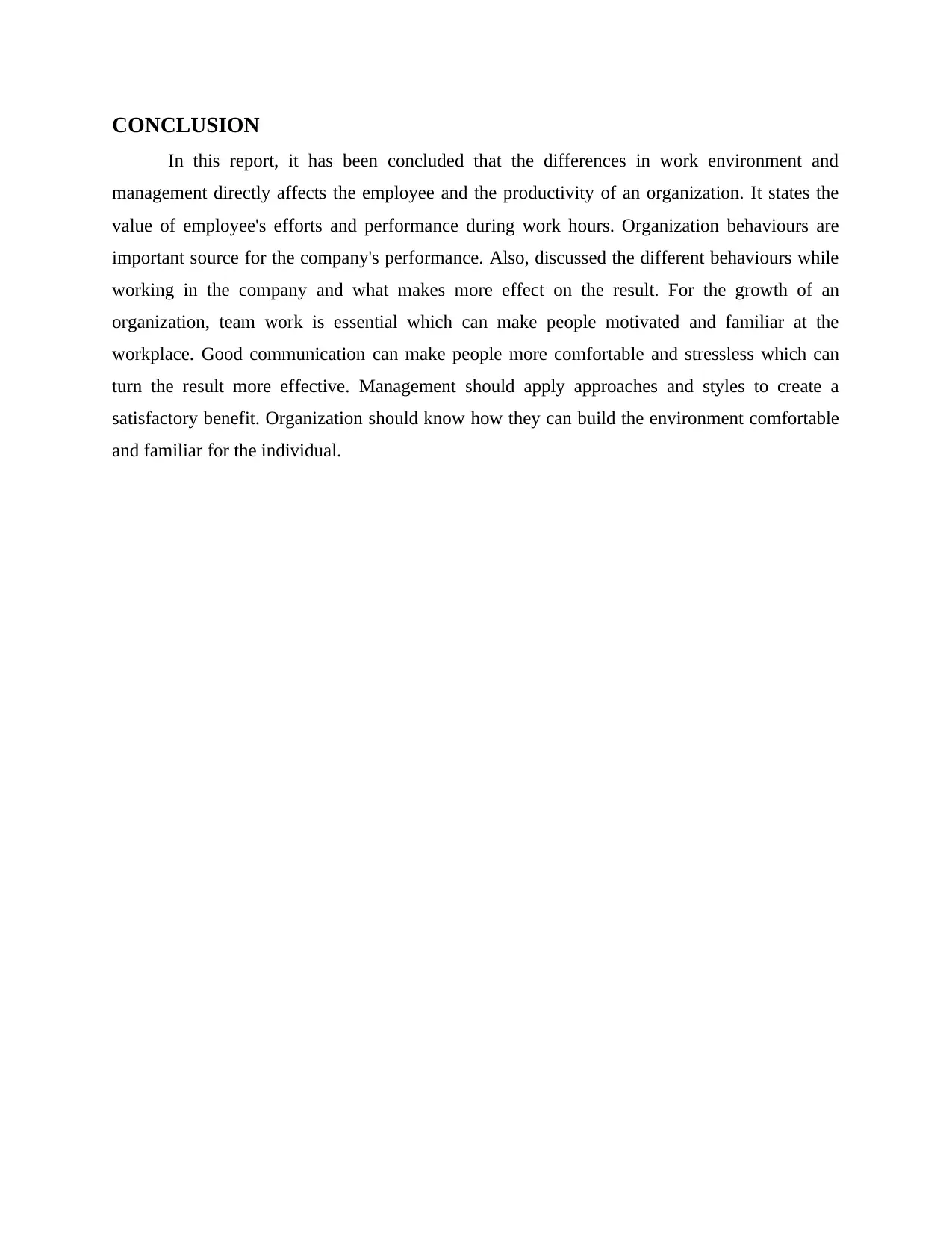
CONCLUSION
In this report, it has been concluded that the differences in work environment and
management directly affects the employee and the productivity of an organization. It states the
value of employee's efforts and performance during work hours. Organization behaviours are
important source for the company's performance. Also, discussed the different behaviours while
working in the company and what makes more effect on the result. For the growth of an
organization, team work is essential which can make people motivated and familiar at the
workplace. Good communication can make people more comfortable and stressless which can
turn the result more effective. Management should apply approaches and styles to create a
satisfactory benefit. Organization should know how they can build the environment comfortable
and familiar for the individual.
In this report, it has been concluded that the differences in work environment and
management directly affects the employee and the productivity of an organization. It states the
value of employee's efforts and performance during work hours. Organization behaviours are
important source for the company's performance. Also, discussed the different behaviours while
working in the company and what makes more effect on the result. For the growth of an
organization, team work is essential which can make people motivated and familiar at the
workplace. Good communication can make people more comfortable and stressless which can
turn the result more effective. Management should apply approaches and styles to create a
satisfactory benefit. Organization should know how they can build the environment comfortable
and familiar for the individual.
Paraphrase This Document
Need a fresh take? Get an instant paraphrase of this document with our AI Paraphraser

REFERENCES
Books and journals
Katz, 2017. Organizational Structure and Advisory. Science Advice to the President. p.291.
Reznikov and et. al., 2018. Fractal-like hierarchical organization of bone begins at the nanoscale. Science.
360(6388).
Mousa and et.al., 2020. Patterns of the Organizational Structure and its Impact in Meeting the
Requirements of the Learn Organization: Applied Research in the Distribution Company of Oil Products
in Basra. International Journal of Psychosocial Rehabilitation. 24(03).
Shahriari, and Allameh, 2020. Organizational culture and organizational learning: does high performance
work systems mediate?. Journal of Workplace Learning.
Porter, 2019. Supply chain integration: Does organizational culture matter?.Operations and Supply Chain
Management: An International Journal. 12(1). pp.49-59.
Wang and Shepherd, 2020. Exploring the extent of openness of open government data–A critique of open
government datasets in the UK. Government Information Quarterly. 37(1). p.101405.
De Widt, and Panagiotopoulos, 2018. Informal networking in the public sector: Mapping local
government debates in a period of austerity. Government Information Quarterly. 35(3). pp.375-388.
Zakoldaev and et.al. 2018, October. Production control organization system in the Industry 4.0 item
designing company. In IOP Conference Series: Materials Science and Engineering (Vol. 441, No. 1 p.
012064). IOP Publishing.
Dike, 2020. Leadership and innovation: Leadership as a Determinant of Innovative Delivery in
Healthcare (Master's thesis, Itä-Suomen yliopisto).
Crist and et. al., 2019. The role of the infection preventionist in a transformed healthcare system:
Meeting healthcare needs in the 21st century. American journal of infection control, 47(4). pp.352-357.
Ghobaei-Arani, Souri, and Rahmanian, 2020. Resource management approaches in fog computing: a
comprehensive review. Journal of Grid Computing. 18(1).pp.1-42.
Таран, 2020. Risk management: approaches and fields of application.
Rost and Alvero,2018. Participatory approaches to workplace safety management: bridging the gap
between behavioural safety and participatory ergonomics. International journal of occupational
safety and ergonomics.
Carnevale, 2018. Organizational development in the public sector. Routledge.
Aula, and Mantere,2020. Strategic reputation management: Towards a company of good. Routledge.
1
Books and journals
Katz, 2017. Organizational Structure and Advisory. Science Advice to the President. p.291.
Reznikov and et. al., 2018. Fractal-like hierarchical organization of bone begins at the nanoscale. Science.
360(6388).
Mousa and et.al., 2020. Patterns of the Organizational Structure and its Impact in Meeting the
Requirements of the Learn Organization: Applied Research in the Distribution Company of Oil Products
in Basra. International Journal of Psychosocial Rehabilitation. 24(03).
Shahriari, and Allameh, 2020. Organizational culture and organizational learning: does high performance
work systems mediate?. Journal of Workplace Learning.
Porter, 2019. Supply chain integration: Does organizational culture matter?.Operations and Supply Chain
Management: An International Journal. 12(1). pp.49-59.
Wang and Shepherd, 2020. Exploring the extent of openness of open government data–A critique of open
government datasets in the UK. Government Information Quarterly. 37(1). p.101405.
De Widt, and Panagiotopoulos, 2018. Informal networking in the public sector: Mapping local
government debates in a period of austerity. Government Information Quarterly. 35(3). pp.375-388.
Zakoldaev and et.al. 2018, October. Production control organization system in the Industry 4.0 item
designing company. In IOP Conference Series: Materials Science and Engineering (Vol. 441, No. 1 p.
012064). IOP Publishing.
Dike, 2020. Leadership and innovation: Leadership as a Determinant of Innovative Delivery in
Healthcare (Master's thesis, Itä-Suomen yliopisto).
Crist and et. al., 2019. The role of the infection preventionist in a transformed healthcare system:
Meeting healthcare needs in the 21st century. American journal of infection control, 47(4). pp.352-357.
Ghobaei-Arani, Souri, and Rahmanian, 2020. Resource management approaches in fog computing: a
comprehensive review. Journal of Grid Computing. 18(1).pp.1-42.
Таран, 2020. Risk management: approaches and fields of application.
Rost and Alvero,2018. Participatory approaches to workplace safety management: bridging the gap
between behavioural safety and participatory ergonomics. International journal of occupational
safety and ergonomics.
Carnevale, 2018. Organizational development in the public sector. Routledge.
Aula, and Mantere,2020. Strategic reputation management: Towards a company of good. Routledge.
1

Ortiz, E.I.R, 2018. The Effects of Leadership Style on the Retention of Public Employees (Doctoral
dissertation, California State University, Northridge).
Andrews, 2017. Strategy implementation style and public service effectiveness, efficiency, and
equity. Administrative Sciences. 7(1).p.4.
Bishop, 2018. Management, organization, and ethics in the public sector. Routledge.
Zadie,2021. Workplace Motivation and Stress on Job Satisfaction of Librarians Working in Public Sector
Universities of Lahore, Pakistan. International Journal of Information Science and Management
(IJISM). 19(2).pp.181-195.
Sun,2021. Public service motivation and proactive behaviour responses to change: A three-way
interaction. Social Behaviour and Personality: an international journal. 49(9).pp.1-15.
2
dissertation, California State University, Northridge).
Andrews, 2017. Strategy implementation style and public service effectiveness, efficiency, and
equity. Administrative Sciences. 7(1).p.4.
Bishop, 2018. Management, organization, and ethics in the public sector. Routledge.
Zadie,2021. Workplace Motivation and Stress on Job Satisfaction of Librarians Working in Public Sector
Universities of Lahore, Pakistan. International Journal of Information Science and Management
(IJISM). 19(2).pp.181-195.
Sun,2021. Public service motivation and proactive behaviour responses to change: A three-way
interaction. Social Behaviour and Personality: an international journal. 49(9).pp.1-15.
2
1 out of 15
Related Documents
Your All-in-One AI-Powered Toolkit for Academic Success.
+13062052269
info@desklib.com
Available 24*7 on WhatsApp / Email
![[object Object]](/_next/static/media/star-bottom.7253800d.svg)
Unlock your academic potential
© 2024 | Zucol Services PVT LTD | All rights reserved.





